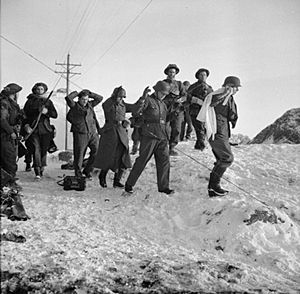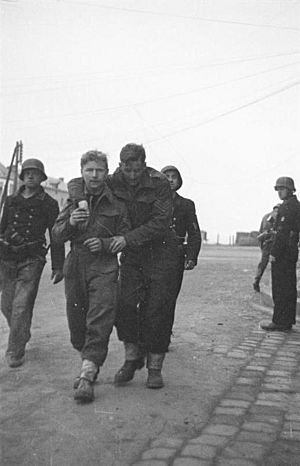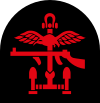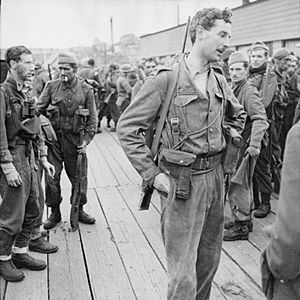British Commando operations during the Second World War facts for kids
The Commandos were special military units formed during the Second World War. They were created in June 1940 by British Prime Minister Winston Churchill. He wanted a force that could carry out quick raids against German-occupied Europe. Churchill described them as "hunter class" troops who could strike hard and fast.
These Commandos were all volunteers. They first came from the British Army, but soon, people from all parts of the UK's armed forces joined. Even foreign volunteers from countries occupied by Germany became Commandos. Over 30 different units and four large assault brigades were formed.
Commandos fought in many different places around the world. They operated from the cold Arctic Circle to Europe, the Middle East, and the Pacific. Their missions varied from small groups landing secretly by sea or parachute to large brigades leading major Allied invasions.
After the Second World War, most Commando units were disbanded. Only the Royal Marine 3 Commando Brigade remained. However, their legacy lives on in today's Royal Marines Commandos, the Parachute Regiment, Special Air Service, and the Special Boat Service. These elite forces can all trace their beginnings back to the original Commandos. Their influence also spread to Europe, inspiring the French Naval Commandos, the Dutch Korps Commandotroepen, and the Belgian Paracommando Brigade.
Contents
Daring Operations of the Commandos
1940: Early Raids and Learning Lessons
The very first Commando-style raid was Operation Collar on June 24/25, 1940. It was a scouting mission on the French coast near Boulogne-sur-Mer. The raid had limited success, but it showed the potential for such special operations.
Another early raid, Operation Ambassador, happened on July 14, 1940, on the German-occupied island of Guernsey. This mission faced many problems. Some soldiers landed on the wrong island, and others had to swim through deep water. They found empty buildings instead of German barracks. This raid taught valuable lessons about planning and intelligence.
1941: Expanding Missions and Tough Challenges
In February 1941, a group of Commandos, known as 'Layforce', went to the Middle East. Their goal was to conduct raids in the eastern Mediterranean. They aimed to disrupt German supply lines.

One of the first major raids from the UK was Operation Claymore in March 1941. No. 3 and No. 4 Commandos attacked the undefended Norwegian Lofoten Islands. They successfully destroyed factories and ships, capturing 216 Germans and important secret codes.
Layforce faced a huge challenge during the Battle of Crete in May. They were sent to disrupt German communications and help with evacuations. Many Commandos were left behind when the evacuation ended. Out of 800 Commandos, about 600 were killed, missing, or wounded.
In June, during Operation Exporter in Syria and Lebanon, No. 11 (Scottish) Commando suffered heavy losses. They were tasked with capturing a bridge over the Litani River.
By July, Layforce was very weak and was disbanded. Many of its members later joined other special forces like the Special Air Service and Special Boat Service.
In November, Operation Flipper aimed to attack German headquarters in Libya and even kill the German commander Erwin Rommel. The raid was not successful, but Lieutenant Colonel Geoffrey Charles Tasker Keyes was awarded the Victoria Cross for his bravery.
December saw two important raids in Norway. Operation Anklet was a diversion for the larger Operation Archery. Operation Archery involved several Commando units and caused significant damage to German facilities and ships at Vågsøy Island. This raid made the Germans send many more troops and ships to Norway.

1942: Famous Raids and Harsh Orders
Operation Postmaster in January 1942 was a daring raid in neutral Spanish Guinea. No. 62 Commando seized an Italian liner, a German tanker, and a yacht.
In March, Operation Chariot, also known as the St. Nazaire Raid, was a very famous and dangerous mission. Commandos and Royal Navy sailors attacked the dry dock at St. Nazaire. The destroyer HMS Campbeltown was packed with explosives and rammed into the dock gates. Commandos fought German forces while the dock facilities were destroyed. Hours later, the explosives in the Campbeltown blew up, destroying the dock gates and causing many German and French casualties. Many Commandos were killed or captured, but their bravery earned two Commandos and three Navy members the Victoria Cross.

The Dieppe raid on August 19, 1942, was a large landing in France. No. 3 and No. 4 Commando supported the main Canadian force. No. 3 Commando faced a German convoy and only a few men landed. They managed to disrupt German artillery, preventing it from firing effectively on the main landing. No. 4 Commando successfully destroyed their target, an artillery battery, and most returned safely. Captain Patrick Porteous of No. 4 Commando received the Victoria Cross.
In September, Operation Musketoon saw No. 2 Commando attack a hydroelectric power plant in Norway. They destroyed the plant, shutting down an aluminum factory. Sadly, some captured Commandos were later killed under the "Commando Order," a harsh German directive against captured special forces.
1943: Global Reach and New Challenges
In early 1943, Commandos continued raiding the Norwegian coast from the Shetland Islands. During Operation Checkmate, seven Commandos sank several ships but were captured and later killed.
In May, several Commando units, including Royal Marine Commandos, joined the Allied invasion of Sicily. They landed ahead of the main force, leading the way.
Later in the year, Commandos carried out reconnaissance raids on French and Low Countries coastlines. These missions, like Hardtack and Tarbrush, gathered vital information about German defenses.
In Burma, 142 Commando Company joined the Chindits, a special unit operating behind Japanese lines. They showed that Allied forces could fight effectively in the jungle, boosting morale.
1944: D-Day and Western Europe

On D-Day, June 6, 1944, several Commando brigades played a crucial role in the Normandy Landings.
- 1st Special Service Brigade (including No. 3, No. 4, No. 6, and No. 45 (RM) Commandos) landed at Ouistreham on Sword Beach. No. 4 Commando, with French troops, held the left flank of the landings for two months.
- No. 41 (RM) Commando landed on the far right of Sword Beach.
- No. 48 (RM) Commando landed on Juno Beach.
- No. 46 (RM) Commando landed at Juno to scale cliffs and destroy a battery.
- No. 47 (RM) Commando landed on the west flank of Gold Beach and captured Port-en-Bessin.
In November 1944, British Commandos were involved in the Battle of Walcheren Causeway in the Netherlands, attacking from the sea at Flushing and Westkapelle.
1945: Final Battles
On April 1, 1945, the 2nd Commando Brigade fought in Operation Roast in Italy. They cleared a strip of land, securing the flank of the British 8th Army. This fierce battle resulted in many prisoners taken and enemy units destroyed. Corporal Tom Hunter of No. 43 Commando (RM) earned a posthumous Victoria Cross for his incredible bravery in this operation.
In the Burma Campaign, the 3 Commando Brigade took part in coastal landings. The campaign ended with the battle of Hill 170 at Kangaw. Lieutenant George Knowland of No. 1 Army Commando was awarded the Victoria Cross for his actions there.
Images for kids
-
Commandos during Operation Archery. The Commando on the left is armed with the Thompson submachine gun.





